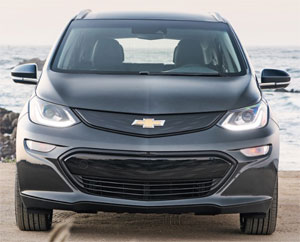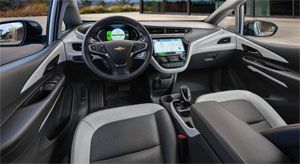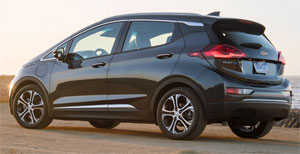2017 Chevrolet Bolt
While last year saw Tesla attract plenty of press and hoopla over their compact Model 3, it is still months away from hitting the streets. But, what has already been hitting the streets for months now, is the Chevrolet Bolt EV. It does just about everything the Model 3 promises, for a whole lot less money. Score one for the bowtie boys!
We’re sure you’ve already heard plenty about this 2017 Chevrolet Bolt EV from us and others, but this is the first chance we’ve had to spend an extended amount of time with one.
As you probably also know, the Bolt EV is the first to achieve the “EV holy grail” of traveling over 200-miles on a single charge and cost under 30-grand, with federal incentives of course.
The Bolt EV uses a 60kWh battery pack from LG that weighs 946-lbs. It powers a 150kW high capacity electric motor with a robust 266 lb-ft. of torque.
 Range is rated at 238-miles; that’s further than any EV not made by Tesla. The Bolt EV earns a 119-Combined MPGe rating, and a near perfect Energy Impact Score, burning just 0.2-barrels of oil annually with no CO2 emissions.
Range is rated at 238-miles; that’s further than any EV not made by Tesla. The Bolt EV earns a 119-Combined MPGe rating, and a near perfect Energy Impact Score, burning just 0.2-barrels of oil annually with no CO2 emissions.
Both the batteries and the motor are liquid-cooled, and can bolt this EV to 60 in just 6.5-seconds. That’s about as fast as a Mercedes-Benz C300 Coupe. But to make sure you don’t get too crazy, top speed is limited to 92 miles-per-hour.
And, if you’ve replaced your “range anxiety” with “battery anxiety”, just relax. Like most EVs and hybrids, the battery pack is covered by an 8-year/100,000-mile warranty.
You’ll probably want a Level 2, 240 Volt charger at home to juice it up, however. With that, it takes about 9-hours to fully charge; verses the almost 60 with standard 120. Even faster Level 3 charging is an option.
Setting aside the environmental benefits, as we’ve learned the more time we spend in the Bolt EV, it really is a great everyday car.
Unlike many subcompacts, it never feels underpowered. In fact it’s enormously peppy off the line, even throwing you back in your seat. It does settle down as you get up to speed, while providing more than enough capability, and is even mildly sporty in corners.
 You can also play with regen braking, dialing up enough to barely have to touch the brake pedal in normal driving.
You can also play with regen braking, dialing up enough to barely have to touch the brake pedal in normal driving.
Overall, the interior is great, with fit and finish among the best from GM, though the piano white trim can cause some glares and reflections on sunny days. The front seating positions are also higher than a typical compact car.
There’s plenty of head and leg room for the rear seat too, and it really can accommodate three across. Even then, there’s ample cargo space at 16.9 cu-ft. That’s more than many subcompact crossovers. For more, the seatbacks fold almost completely flat.
It even has that small crossover look, with no obvious EV elements whatsoever. Being fully “in the now”, Chevy not only applied the “floating roof” treatment to the rear pillars, but to the front ones as well.
And, wherever we went, the Bolt EV attracted quite a bit of attention. We even got a few thumbs up from petrol drivers.
 On that under 30G price, once you factor in $7,500 worth of federal tax credits, you’re left with $29,995. State credits may lower it more. Up level Premier trim, with heated leather seats front and rear, and a host of other niceties, can be yours for $34,280.
On that under 30G price, once you factor in $7,500 worth of federal tax credits, you’re left with $29,995. State credits may lower it more. Up level Premier trim, with heated leather seats front and rear, and a host of other niceties, can be yours for $34,280.
The bad news for some, is that the Bolt EV isn’t available everywhere yet. That will take till the end of summer, and even then not all Chevy dealers will have made the upgrades required to sell and service it. Also, looking at it from a pure penny pinching standpoint, many 40 MPG subcompact cars are available for much less money.
So, while it’s impossible to predict success of the 2017 Chevrolet Bolt EV, as fuel prices more than anything else will ultimately make or break its fortunes, it’s easy to recognize when the game has been changed. It may not offer the performance or cache of a Tesla, but the Bolt EV has clearly set a new standard for mass market electric vehicles; a real car that can be used by just about everybody, every day. In other words, the future has arrived, and it’s built in Detroit.
Specifications
- Torque: 266 lb-ft.
- 0-60 mph: 6.5 seconds
- Energy Impact: 0.2 barrels of oil/yr
2024 Toyota Land Cruiser
Toyota’s Go Anywhere Globetrotter Returns To U.S.
Every once in a while, we all need a reset. A time to get back to basics and prioritize the things that really matter. Well, for the Toyota Land Cruiser that time is now. So, let’s find out if that means bigger and better things for Toyota’s iconic off-roader.
The Toyota Land Cruiser’s status among the global off-road community is legendary, and it’s hard to imagine there’s any corner of the earth where a Land Cruiser hasn’t kicked up a little dust or mud. Well, 2024 sees the return of the Land Cruiser to the U.S. market after a 3-year hiatus, getting a major reset for the journey.
The reset comes mostly by no longer being based on the large three-row “300-series” chassis, but a new version of the smaller “200-series,” now known as the J250. As with the latest Tacoma, it uses the Tundra pickup’s full-size steel frame.
While the main Land Cruiser model, which goes by simply Land Cruiser, is packed full of luxury and convenience features, there is also a stripped-down model known as the 1958, honoring the first year the Land Cruiser made landfall here in North America. And it is that 1958 we have here, and we were glad to see it, as it also celebrates the original’s back-to-basics approach as a blank canvas for you to personalize as you tackle more and more adventures.
Not that it’s fully stripped down, as 8-inch touchscreen infotainment, a 7-inch full-color multi-information display, and automatic climate control are still standard. Plus, some seriously durable materials, and great heated cloth front seats that throw off some get serious 1990s Tacoma vibes.
But outside, there’s a definite lack of flashy trim and basic looking 18-inch wheels with Yokohama Geolander all-season tires; plus, big chunky bumpers and tilt-up back glass, which is a rarity that we appreciate. Though there is a little too much plastic in places that are sure to see some abuse if you do any significant off-roading.
It even feels a little rough around the edges, but for us it just adds to the rugged old-school utility vibe in a good way.
We did just that, both here in the Mid-Atlantic as well as in the California desert; and while there are some tech-forward driving aids, the actual hardware is in most cases plenty to get things done. That includes standard full-time dual-range four-wheel-drive, locking center and rear diffs, and 8.7-inches of ground clearance. A front stabilizer bar disconnect is also available to allow for increased articulation.
Who needs a V6 or even a V8 when you’ve got Toyota’s i-FORCE MAX setup at your disposal with 326 horsepower and 465 lb-ft of torque coming from a 2.4-liter turbo-four with an electric motor sandwiched between the engine and its eight-speed automatic transmission. Low speed torque delivery is impressive. It even feels a little rough around the edges, which may be a turn off to some, but for us it just adds to the rugged old-school utility vibe in a good way.
And it certainly feels quicker than an off roader needs to be, with an instant torque dump as soon as we eased on the throttle at our Mason Dixon test track; helping us get to 60 in 8.1 seconds and through the quarter-mile in 16.3 seconds at 86 mph. Considering the Land Cruiser’s terrain conquering mission, it behaved quite well in our handling course; it was plenty responsive to inputs, with less body roll than we expected and plenty of grip from the tires. The steering was light and quick but as expected didn’t provide much feel. Other than significant nosedive, braking performance was exceptional. Only 107-feet to panic stop us from 60 mph.
With the shift to the smaller size, there’s no more third row available, and cargo capacity now comes in at 46.2 cubic-feet with a max of a still healthy 82.1. Now, the best part of the Land Cruiser’s return is the entry price of $57,445. That’s about 30-grand less than what the last Land Cruiser went for back in 2021.
Whether it’s over the top fashion trends, mullets, or zombies; just when you think they’re dead, they come roaring back to life. Of course, we’re much happier to see the resurrection of this 2024 Toyota Land Cruiser than any of those things. Toyota is one brand that still recognizes the value of full-framed rugged rigs and has also acknowledged that sometimes less really is more. The Godfather of Toyota off-roading is back and better than ever.







